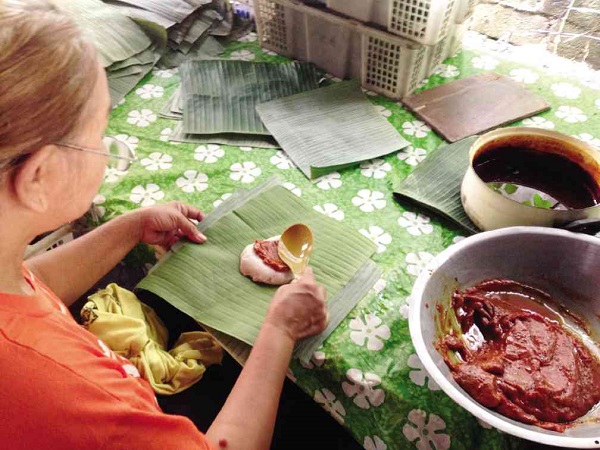Pampanga village women show way to rise above disasters

PILAR Cabigting prepares “tamales” that helped her rise from the disaster wrought upon her community in the village of Cabalantian in Bacolor town, Pampanga province, by the eruption of Mt. Pinatubo and the lahar flows that followed it. TONETTE OREJAS/INQUIRER CENTRAL LUZON
BACOLOR, Pampanga—When disaster strikes and takes everything except your life, what do you do to overcome it?
Several women in Barangay Cabalantian here show a way. Their tack: rebuild by resuming the production here of native delicacies.
When rain washed down the sediments that Mt. Pinatubo spewed out in its 1991 eruptions, 6- to 8-meter-high lahar cascaded down in the early morning of Oct. 1, 1995, overwhelming the Pasig-Potrero River and swarming toward the village like stampeding horses.
Defying tragedy
“[Lahar] buried everything in its path. We lost our house, the old stove oven, the large pots and big wooden ladles,” said Pilar Cabigting, 65, sharing details of what local folk now call the “Cabalantian Tragedy.”
Article continues after this advertisementOne of the last standing structures was San Guillermo Church, which rattled the faithful.
Article continues after this advertisementCabigting realized she had nothing to build on. But she was persistent. She had to support a husband, who ended up suffering a blood clot in the brain after a tricycle accident and who eventually passed away in 1997. There were five children to raise and send to school.
Cabigting knew, too, that making “tamales” could still bring in good cash because these were popular snacks. The homegrown food is a rice pudding enriched with coconut milk, topped with peanuts, chicken or ham, and wrapped in banana leaves. Bacolor town also makes “suman bulagta” (glutinous rice topped with sugar and “latik”).
“I have trust in my little talent. I knew I was good at making these [delicacies]. I know God would always help,” Cabigting said.
She began cooking tamales and other rice products in 1972, learning the culinary side and commerce through her husband’s neighbors. Cabigting is a native of San Simon town, southeast of Bacolor.
P1,000 in savings
After ensuring that her family was safe in two huts she built as their home and work area, Cabigting resumed the enterprise on savings of less than P1,000.
She sold the products in San Fernando City or in Metro Manila. This was a backbreaking work where the cooking started at 3 a.m. and the selling at 5 a.m.
Eighteen years after the disaster, 20 women in Cabalantian still live on the same enterprise. More women do the enterprise in resettlements.
Mayor Jose Maria Hizon said the resilience of Cabigting and other makers of delicacies made them rise above the disaster. “They were not afraid to get back on their feet. These women were self-reliant,” he said.
He said the sales of native delicacies also helped the local economy. “People come around simply looking for the products,” he said.